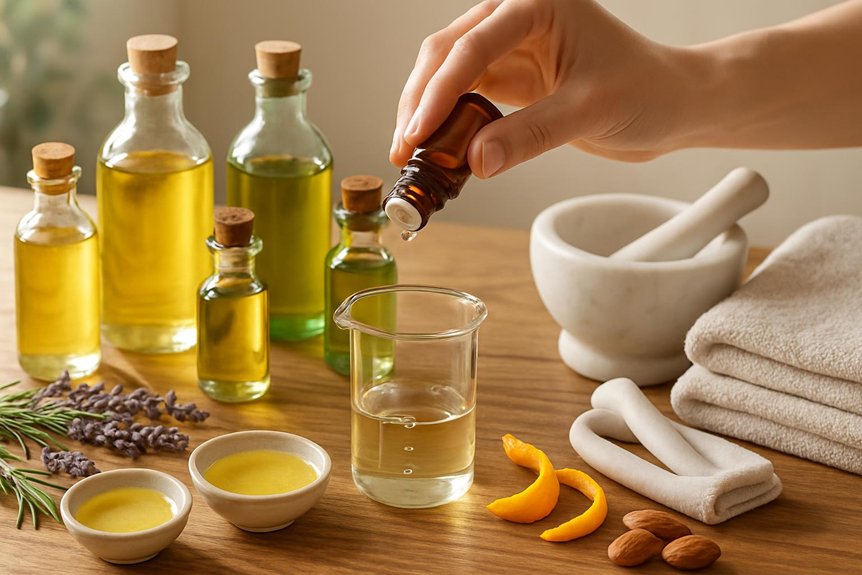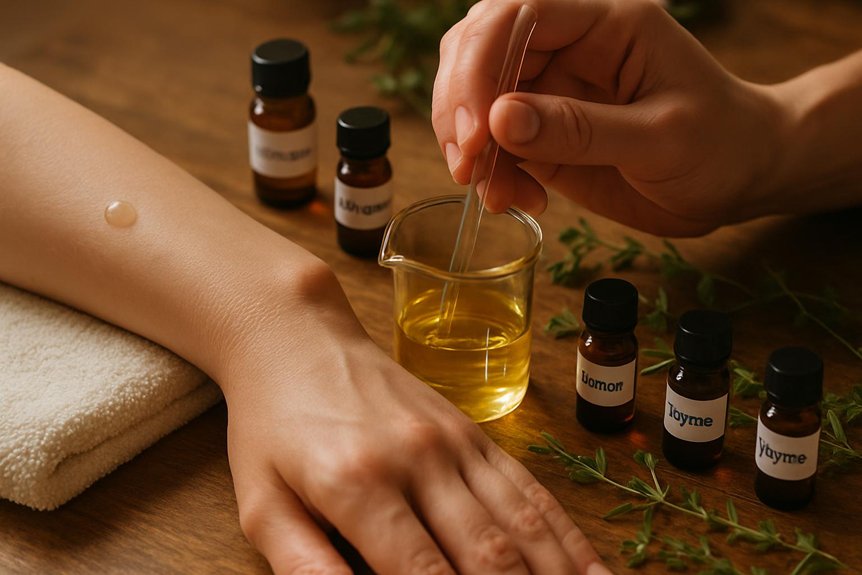To make aromatherapy massage oils, select fresh, cold‑pressed carrier oils (e.g., jojoba, sweet almond) and high‑quality essential oils. Dilute safely: 1–2% for adults (6–12 drops per 30 ml), 1% in pregnancy, 0.25–0.5% for sensitive skin. Patch test a 1% blend on the inner forearm for 24 hours. Use clean glass tools, measure precisely, blend gently, and store in amber bottles at 15–20°C. Label with date, dilution, and contents. Citrus oils may be phototoxic. Further guidance follows.
Understanding Essential Oils and Carrier Oils

Why do massage oils work differently on the body? Essential oils are concentrated plant extracts rich in volatile compounds that influence scent perception and skin response, while carrier oils are lipid-based, non-volatile fluids that dilute and deliver them.
At Spa & Massage clinics in London, therapists distinguish roles: essential oils provide aromatic nuance and targeted effects; carriers modulate glide, absorption, and skin feel. Jojoba mimics skin sebum and resists oxidation; sweet almond offers smooth slip for longer strokes; fractionated coconut remains light and non-greasy.
Viscosity, comedogenicity, and oxidative stability determine comfort and after-feel. Skin type and preferences guide selection to support closeness without irritation. Our therapists prioritise skin integrity, patch awareness, and clean, fresh oils to preserve intimacy and effectiveness. For those looking to broaden their understanding of massage and wellness, exploring the healing power of Reflexology can offer complementary benefits and enrich the overall therapeutic experience.
Safety Guidelines and Dilution Ratios We Use in Clinic
In Spa & Massage clinics, essential oils are diluted to evidence-based concentrations—typically 1–3% for healthy adults, with lower ratios for sensitive skin, pregnancy, or facial areas.
Each bespoke blend is patch tested on a small area, observed for 15–20 minutes, and adjusted or discontinued if erythema, itching, or irritation appears.
This protocol standardises safety across locations while allowing therapists to personalise blends responsibly.
Essential Oil Dilutions
How much is enough when blending essential oils for massage? Spa & Massage teaches that dilution is the key to comfort, efficacy, and skin safety.
For healthy adults, a 2% dilution is standard: 12 drops essential oil per 30 ml carrier.
For delicate areas, first-time sessions, or extended full‑body work, 1% (6 drops/30 ml) is preferred.
For short, localized application, 3% (18 drops/30 ml) may be appropriate when skin integrity is intact.
Citrus oils high in limonene, spice oils, and oxidized oils raise irritation risk; our therapists keep these at 0.5–1% unless clinically indicated.
Pregnancy massage follows a conservative 1% maximum with suitable oils only.
Face and neck blends stay at 0.5–1%.
Sensitive skin, elders, and those on medications lean lower.
Carrier choice matters—jojoba and fractionated coconut are reliably gentle.
Patch Testing Protocol
A clear patch testing protocol underpins Spa & Massage’s aromatherapy safety.
In clinic, blends are prepared with carrier oils and essential oils at 1% for the first exposure; sensitive areas receive 0.5%. A pea-sized amount is applied to the inner forearm, covered, and left for 24 hours. No washing, heat, or exercise that induces heavy sweating during this period.
Therapists document baseline skin status and check at 30 minutes, 8 hours, and 24 hours for erythema, pruritus, edema, or vesicles.
If irritation occurs, the area is cleansed, product discontinued, and the client is flagged for alternative oils.
For known sensitivities, Spa & Massage starts at 0.25% and uses single-oil trials.
Pregnant clients follow 0.25–0.5% only.
All reactions and preferred blends are recorded for future sessions.
Tools and Ingredients You’ll Need at Home
To mix safely at home, Spa & Massage outlines a core toolkit: glass measuring jug, stainless-steel or glass bowls, 1–2% accurate digital scale or pipettes, amber dropper bottles with labels, and nitrile gloves.
For carriers, our therapists recommend stable, skin-friendly oils such as sweet almond, grapeseed, fractionated coconut, or jojoba, chosen for skin type and oxidation resistance.
Essential oils should be high quality, patch-tested, and used within clinic-level limits (typically 1–2% for adults), avoiding contraindicated oils for pregnancy, epilepsy, anticoagulant use, or photosensitizing citrus on sun-exposed skin.
Core Tools Checklist
Good tools simplify safe, consistent blending at home. Spa & Massage recommends a small, accurate digital scale (0.1 g resolution) for reliable dilutions; droppers or pipettes for transferring essential oils without skin contact; and glass beakers or shot glasses for measured mixing.
Amber or cobalt glass bottles with reducer inserts protect blends from light and over-pouring. Labels and a fine-tip pen record date, dilution, and contents—essential for safety.
Isopropyl alcohol (70%) and lint-free cloths support hygienic wipe-downs; mild, fragrance-free soap cleans vessels. A silicone mat protects surfaces. Nitrile gloves reduce sensitisation risk during handling. A stainless steel funnel prevents spills.
Distilled water is useful only for cleaning, not blending oils. These are the same fundamentals used by Spa & Massage therapists.
Carrier Oils Selection
With tools in order, attention shifts to the base that carries the aromatics across the skin: the carrier oil. Selection hinges on skin feel, absorption rate, and sensitivity.
In Spa & Massage clinics, therapists favour light, stable oils—sweet almond for glide, fractionated coconut for a clean finish, and grapeseed for quick absorption. For delicate skin, jojoba’s skin-mimicking wax esters reduce residue and congestion risk.
Evidence supports choosing cold-pressed, unrefined oils for intact nutrients, with a preference for fresh stock to limit oxidation. A faint, neutral scent preserves the essential oil profile.
Clients with nut concerns should avoid almond and choose coconut, grapeseed, or jojoba. Patch-testing the carrier alone is prudent. Store oils in amber bottles, cool and dark, and discard if odour turns sharp.
Essential Oils Safety
A foundational safety plan precedes any blending of essential oils at home. Spa & Massage advises using pharmacy-grade tools: glass droppers, amber bottles, nitrile gloves, and labels with dates, dilutions, and ingredients.
Patch-test each oil at 1% in carrier on the inner forearm for 24 hours.
For full-body massage, keep total dilution at 1–2% (3–6 drops per 10 ml carrier); limit to 0.5–1% for pregnancy, sensitive skin, or the elderly.
Avoid phototoxic citrus oils (e.g., expressed bergamot) before sun exposure; choose bergapten-free when needed.
Never ingest oils or apply undiluted to skin.
Store tightly sealed, away from heat and light; note oxidation risks with citrus and pine oils.
In our clinics, therapists track contraindications, medications, and asthma or epilepsy histories before blending.
Step-by-Step Method to Blend Your Massage Oil
Precisely blended massage oil begins with preparation: equipment is sanitised, hands are washed, and a clean, dry glass beaker or dark glass bottle is set out.
At Spa & Massage, therapists measure a carrier oil first (e.g., sweet almond, grapeseed, or fractionated coconut), then add essential oils to 1–2% dilution for full-body use, or up to 3% for localized areas on intact skin.
Drops are counted precisely, then the vessel is gently rolled to combine—never shaken, to reduce aeration.
A patch test is performed on the inner forearm; if clear after 24 hours, the blend is suitable.
Label with date, dilution, and oils used. Store cool and dark.
For sensitive skin, pregnancy, or medical conditions, our therapists recommend a 0.5–1% dilution and fragrance-free bases.
Recipes for Relaxation, Muscle Relief, and Energy
Three focused aromatherapy blends—relaxation, muscle relief, and energy—can be prepared using evidence-based dilutions and skin-safe essential oils. Spa & Massage recommends 2% total dilution for full-body massage: 12 drops essential oil per 30 ml carrier (sweet almond or fractionated coconut).
Relaxation (evening): 6 drops lavender (Lavandula angustifolia), 3 drops Roman chamomile (Chamaemelum nobile), 3 drops cedarwood atlas (Cedrus atlantica). Soothing, grounding, pillow-soft.
Muscle relief (post-exertion): 5 drops sweet marjoram (Origanum majorana), 4 drops rosemary ct. camphor (Rosmarinus officinalis), 3 drops black pepper (Piper nigrum). Warming, circulation-supportive. Avoid during pregnancy.
Energy (daytime): 5 drops sweet orange (Citrus sinensis), 4 drops peppermint (Mentha x piperita), 3 drops rosemary ct. cineole. Crisp, uplifting. Avoid peppermint on chest in breastfeeding.
In our clinics, therapists blend fresh per session, massage slowly into large muscle groups, and keep citrus blends for daytime use due to photosensitivity risk with expressed citrus oils.
Skin Type Considerations and Patch Testing

Those blends work best when matched to skin needs and verified for tolerance. Normal skin accepts balanced dilutions (1–2% essential oils in a neutral carrier). Dry or mature skin benefits from richer carriers (sweet almond, jojoba) with soothing oils like lavender or frankincense at 0.5–1%.
Oily or congestion‑prone skin prefers lighter carriers (grapeseed) and non‑comedogenic choices; consider tea tree or petitgrain at ≤1%.
Sensitive, reactive, or barrier‑impaired skin requires minimal fragrance load (0.25–0.5%) and allergen‑lean oils; avoid known irritants and hot oils.
At Spa & Massage, therapists recommend a 24–48 hour patch test: apply a pea‑sized diluted blend to the inner forearm or behind the knee, cover, and observe.
Any redness, itching, heat, or swelling warrants reformulation or avoidance. Clients with eczema, psoriasis, pregnancy, or allergies should seek personalised guidance.
Storage, Shelf Life, and Labelling Best Practices
Good bottles and cool, stable conditions keep massage blends safe and effective. Spa & Massage advises storing finished oils in dark glass (amber or cobalt), filled to the shoulder to limit oxygen. Keep between 15–20°C, away from sunlight and humidity; bathrooms and warm windowsills hasten oxidation. Wipe rims, cap tightly, and decant small working volumes to reduce repeated air exposure.
Shelf life depends on the carrier: jojoba up to 24 months; fractionated coconut 24–36 months; sweet almond 12 months; grapeseed 6–9 months. With essential oils added, use within 6–12 months, or sooner if high in citrus or other oxidatively sensitive oils. Discard if odor turns paint-like or rancid.
Labels should include date blended, ingredients with percentages, dilution, batch code, and safety notes (e.g., phototoxicity).
How Our Therapists Personalise Blends During Treatments
Often, therapists at Spa & Massage begin by conducting a brief, structured consultation to identify goals (e.g., pain relief, stress reduction, sleep support), sensitivities, and contraindications. They verify medications, pregnancy status, allergies, and recent procedures. Patch testing is performed when history suggests reactivity.
Based on findings, they select a skin-compatible carrier (often sweet almond or fractionated coconut) and build a targeted blend at conservative dilutions: typically 1–2% for full-body massage (6–12 drops per 30 ml), 0.5–1% for pregnancy or sensitive skin. They avoid dermal irritants over compromised skin and exclude oils contraindicated for hypertension, anticoagulants, or epilepsy.
During treatment, they adjust in micro-steps—one drop at a time—while monitoring breath, tone, and skin response.
Post-session, they provide aftercare, hydration guidance, and personalised at-home inhalation advice.
Conclusion
In the end, crafting massage aromatherapy oils at home proves thrillingly unglamorous: scales, drop counts, patch tests, and labels—hardly the stuff of scented fantasies. Yet precision safeguards skin, preserves potency, and targets outcomes—relaxation, muscle ease, calmer sleep—with clinic-grade dilution and evidence-led choices. Ironically, the most “natural” blends are the most measured: clean tools, dark bottles, expiry dates. Personalisation follows rules, not whims, and touch works best when chemistry, safety, and method quietly do the heavy lifting.